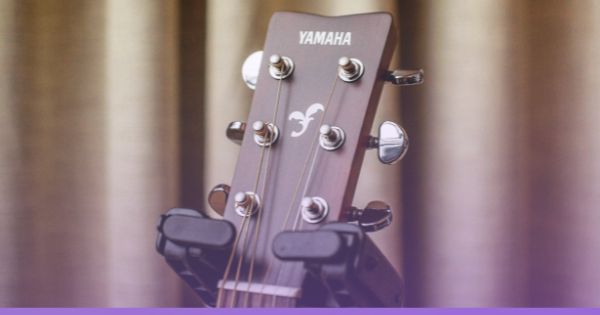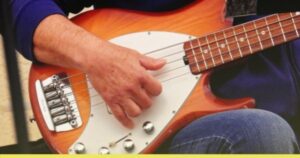Note: This guide has all the answers you’ll need for the question – Are Yamaha guitars good? If you’re thinking of choosing Yamaha as your next guitar brand then I’ve compiled detailed (and honest) information about Yamaha’s guitar types, models, their significance & alternate brands to help you make the right decision.

Despite the fact that great musicians like Paul McCartney and Santana have played Yamaha guitars, the brand has remained obscure onstage and hasn’t received the credit it deserves.
You might be shocked to learn that, despite not taking centre stage, the Yamaha Pacifica electric guitar series once outsold Fender Stratocasters, and players still adore this line of instruments.
Depending on your needs, Yamaha’s wide selection of mid-priced acoustic and electric guitars may be on your shortlist.
It can be difficult to know if you are making a wise purchase if you don’t have much experience with guitars and may wonder is Yamaha a good guitar brand?
If you’re a beginner, this article will serve as a solid introduction to Yamaha guitars, and we’ll cover some of the more well-known models.
Let’s examine their construction, the location of their manufacture, and some of the best Yamaha guitars for beginners, both electric and acoustic.
Types of guitars by Yamaha and their significance
- Yamaha Electric guitars:
If you’re considering purchasing an electric guitar, I strongly advise you to at least try out a Yamaha before making your choice.Although many people like well-known brands like Fender, Gibson, or Ibanez, there are many people who question whether are Yamaha electric guitars good?
With costs ranging from roughly $200 to $650, Yamaha’s Pacifica electric guitar line is currently particularly well-liked because it offers models for beginners and intermediate players.
Recently, Yamaha introduced the Revstar line of guitars, which range in price from $400 to $1,000 depending on the features and mostly employ Mahogany or Nato bodies.
Major guitar shops report that various Pacifica models often account for between 5 and 10 percent of all guitar sales, and the midrange Revstar models currently account for about 35 percent of all sales. -
Yamaha Acoustic guitars:
The most common question I get asked is, does Yamaha make good acoustic guitars? Since affordability is Yamaha’s speciality when it comes to guitars, you can buy their most popular models for low to medium costs, and the good news is that they offer excellent value.You will hear the FG800 dreadnought mentioned frequently, and for good reason—Yamaha hammered the nail on the head with its design.
The FG830 series, which is manufactured with fine woods and solid tops, is another very popular option.The Yamaha F335 is their steel-string acoustic with the lowest price, and as you would have predicted, they sell a tonne of them. However, I do not suggest this guitar since it has a laminated top, which severely restricts the guitar’s tonal range, and because, after some time spent learning, this guitar would quickly grow boring to you.
-
Transacoustic guitars:
Take a look at the FG-TA Transacoustic Dreadnought if you’re looking for a decent, well-known acoustic electric guitar.
One of Yamaha’s key selling points for guitars is that it is a brand-new innovation.
The Transacoustic is a unique system that works like an amp within your guitar and includes built-in special effects. - Acoustic – Electric Yamaha guitars:
The movement of the strings on entry-level acoustic guitars is frequently a little high, so bear that in mind. If possible, try playing a friend’s guitar to get a feel for the action. You can also pick up a more expensive guitar in a store to get a feel for it.
You can ask the guitar store to reduce the action of a new guitar if it seems too high once you have a sense of what a decent action feels like.Yamaha FGX800C is a fantastic initial option if you’re looking for a guitar that you can connect directly into an amplifier (also featured in our list for best guitars for women).
The Yamaha System-66 inbuilt pre-amp and electronic tuner on this model, which has a cutaway body shape, is a terrific feature that makes it simpler to tune your guitar.
With a solid Sitka spruce top, scalloped bracing, and an integrated EQ unit, this guitar is likely to accompany you for a longer period of time during your guitar-playing journey. At $320, it represents good value.
Yamaha produces excellent entry-level classical guitars that are reasonably priced. Although you’ll have to compromise on quality or they’ll be purchasing a less expensive model, the quality is typically adequate for a practise or beginner guitar.You should go elsewhere if a very high-quality instrument is what you’re after. Despite the fact that Yamaha produces high-quality instruments, you can obtain a better guitar with a nicer brand name for less money.
Overall, the worst thing about Yamaha classical guitars for beginners is that they have a distinctive appearance that doesn’t change much from model to model. As a beginner, your choice shouldn’t be based just on how your guitar looks.
-
Yamaha Bass guitars:
Rock, blues, and metal are all genres that Yamaha basses can handle, but R&B and Soul are where they really stand out.The construction quality of Yamaha basses is their most notable characteristic. They are appropriately referred to as “an axe.” Basses made by Yamaha are maintenance-free and long-lasting. You cannot expect better workmanship for the money you spend.
Their necks are quick and incredibly natural-feeling. The broad pickups on Yamaha basses with humbuckers also provide a great playing experience “above the ramp.” Placing the thumb and playing become quite simple.
Other Yamaha guitars are featured here:
- Yamaha FG800 – The Best Guitars For Fingerstyle & The Best Guitars With Low Action
- Yamaha RevStar RS502 – The Best P90 Guitar
- Yamaha CGS102A Half-Size Classical – The Best 1/2 Size Guitar
- Yamaha APXT2 & Yamaha JR2TBS- The Best 3/4 Guitar
- Yamaha F335 – The Best Guitars For Large Hands
- Yamaha APXT2EW – The Best Thin Neck Acoustic Guitars For Small Hands
Does Yamaha make good-quality guitars?
Hardware:
Yamaha guitars are constructed like tanks; they are durable and trustworthy in almost any situation.
Although the hardware is generally the same across the board, the less expensive models will likely have plastic saddles and bridge pins, less expensive tuners, and no electronics.
The L-series and Red Labels would have significantly higher quality tuners, bridges, nuts, saddles, etc. However, that is expected!
In addition, Yamaha leads the sector in terms of innovation. This is evident in some of their more recent products, such as the TransAcoustic, Silent Guitars, and their exclusive A.R.E. treated flagship acoustics.
Playability:
All of Yamaha’s guitar models are really playable once they are correctly set up, in my experience.
Additionally, these guitars’ shape and general weight distribution give them extra comfort points. Yamaha products fall within the category of being rather lightweight.
Quality Control:
This is one area, in my opinion, where Yamaha is seriously underappreciated.
Even with their cheapest items, they have excellent quality control. I haven’t found any brand of mass-produced guitars that can deliver the same consistency.
Value for Money:
Simply said, Yamaha guitars in the entry-level to mid-range price range offer outstanding value for the money.
Where are Yamaha guitars made
Many people wonder, is Yamaha a Chinese company? However, Torakusu Yamaha established Yamaha in 1887 in Japan with the goal of increasing the number of people who owned personal musical instruments. In 1940, Yamaha started making guitars, and in 1966, it started selling them internationally.
Nylon-string classical acoustic guitars first appeared in the 1940s, but 1966 turned out to be a year that had a significant impact on Yamaha guitars. SG electric guitars, SB electric basses, FG steel-string acoustics, and a guitar amplifier were all introduced during that period. Numerous additional products have since been introduced, ranging from amps and effects pedals to an ever-expanding selection of top-notch guitars from the SG, BB, FG, and Revstar families.
Over a million people a year become acoustic guitar players after purchasing their first Yamaha as a result of the brand’s growth over time, making it one of the best-selling acoustic guitar manufacturers on the planet.
Yamaha has a history of innovation in the guitar industry. As an illustration, the TransAcoustic guitar was introduced in 2017 and represents a novel new category of hybrid acoustic guitars with onboard reverb effects for a more stimulating and exciting playing experience.
Yamaha, a major guitar manufacturer with a long history, showed its dedication to the future of the global guitar market by bringing Line 6 into the Yamaha family in 2014.
Line 6 debuted in 1996 with the release of the AxSys 212, the first digital modelling amp in the world, and was responsible for the revolutionary POD multi-effect, which debuted in 1998.
The new flagship of multi-effects processors for guitarists, the Helix series of devices, was unveiled by Line 6 in 2015.
In 2018, Yamaha Guitar Group, Inc., a U.S.-based subsidiary of Yamaha Corporation, Japan, was established. This organisation brings together internal teams focused on meeting the needs of guitarists all over the world.
What all does Yamaha make?
We all know that Yamaha is best renowned for producing two-wheelers. Although its motorcycles are unquestionably its best-selling items, Yamaha is also a world leader in the production of pianos. Yamaha is a renowned name in the piano and keyboard industry.
Yamaha today produces computer components, household appliances, and a variety of vehicles, including golf carts, in addition to these two key goods. The business offers a wide variety of items and is truly a conglomerate.
Should you buy a Yamaha guitar?
Yamaha guitars are, in a nutshell, really good, especially when you look at the quality-price relationship.
For many other manufacturers, this is not the case, therefore I’d even venture to say that you receive a little bit more than you pay for.
As we’ve previously indicated, Yamaha has never enjoyed the same status as Fender, Martin, Gibson, and the like, but they are renowned for offering great quality for their asking costs.
Despite the fact that Yamaha may not come to mind when you think of performing instruments, you will frequently see them on large stages and in classical guitar concerts.
Yamaha guitars are of the highest caliber as evidenced by the fact that Santana, Robben Ford, and Bruce Springsteen have all used them.
It’s dubious that any other manufacturers could assert greater standards if you only consider the build and component quality of Yamaha guitars.
Even in their midrange and beginner series, you will find quality at least on par with that of any other well-known brand. Their premium professional-grade guitars are made with meticulous attention to detail.
Best alternatives for Yamaha guitars
- Gibson – The most famous Gibson guitar is the Les Paul, which has been a stalwart in the music world for decades. The Gibson Les Paul is a premium guitar that is built in the USA and is available in a number of various configurations. Gibson has maintained a fair amount of consistency in its designs and styling, much like Fender. Other well-known Gibson electric guitars, besides the Les Paul, include the SG, Flying V, Explorer, ES-335, and Firebird. They have some traditional acoustics, like the Hummingbird.
- Fender – Fender is likely one of the most recognisable guitar brand names out there, along with Gibson. Some of the greatest guitars ever manufactured include models like the Stratocaster and Telecaster, which are indelible in history. For more than 60 years, their USA-made instruments have influenced almost every musical genre.
- Martin – An American guitar manufacturer with a focus on acoustic instruments is called Martin. Their legacy extends back to 1833, and the majority of their instruments are still made at their plant in Nazareth, Pennsylvania. In many ways, Martin has influenced the appearance and tone of the American acoustic guitar. In reality, they created the now-iconic dreadnought design to aid American country musicians who want greater guitar projection onstage.
- Guild – American guitar manufacturer Guild creates several incredible semi-hollow electric guitars, including the Starfire and the Aristocrat. These guitars look the part and sound exactly like they belong in a classic rock band. The Newark Street collection has brought back a number of vintage Guild models. Even though these guitars are very cool, Guild really excels in the acoustic market.
In Conclusion
I must admit that Yamaha is NOT JUST a beginner-friendly guitar brand. It competes head-to-head with all those well-known American brands and is a serious player in today’s fiercely competitive market.
I hope this article has taught you everything there is to know about Yamaha guitars.

Tania B.
Ola! I am Tania and I have studied music at Trinity College, London. My love for music started early when I was about 12 years old and I've been around the block when it comes to problems while buying a guitar that suits all your needs. I hope you find my tips useful!


